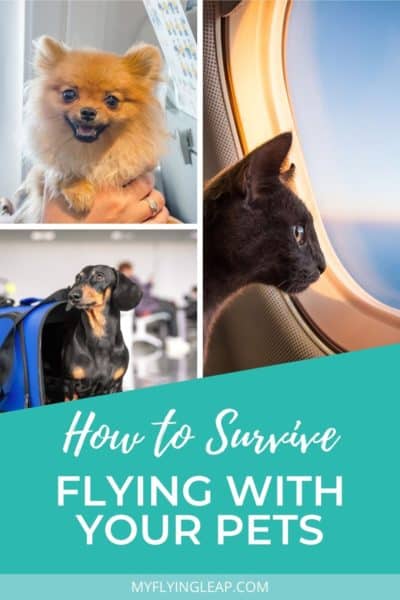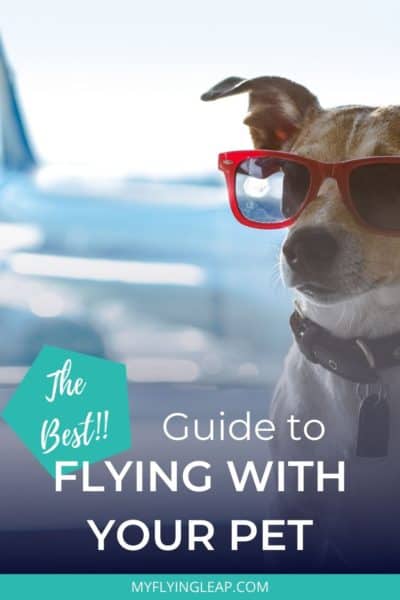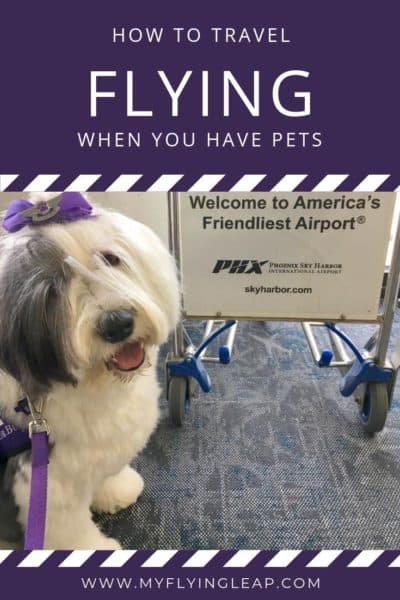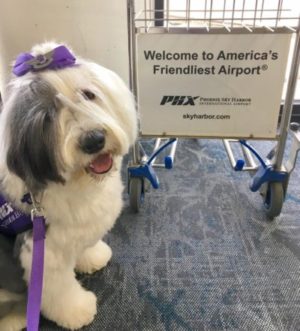Pet Transport: Flying with Your Pets
Though you might think traveling with your pet may be really fun, some aspects of pet transport can be rather daunting. There are a lot of things to consider regarding travel, and especially safety.
Even more, depending upon where you are traveling and how you choose to travel. Flying with pets is one of those transport options that you really need to be prepared for.
There is a lot to consider when flying with your pet. It can be challenging, but if you’re prepared, it can be a pleasant experience as well. Here is what you need to know to help improve your odds to have a safe and at comfortable flight with your pet.
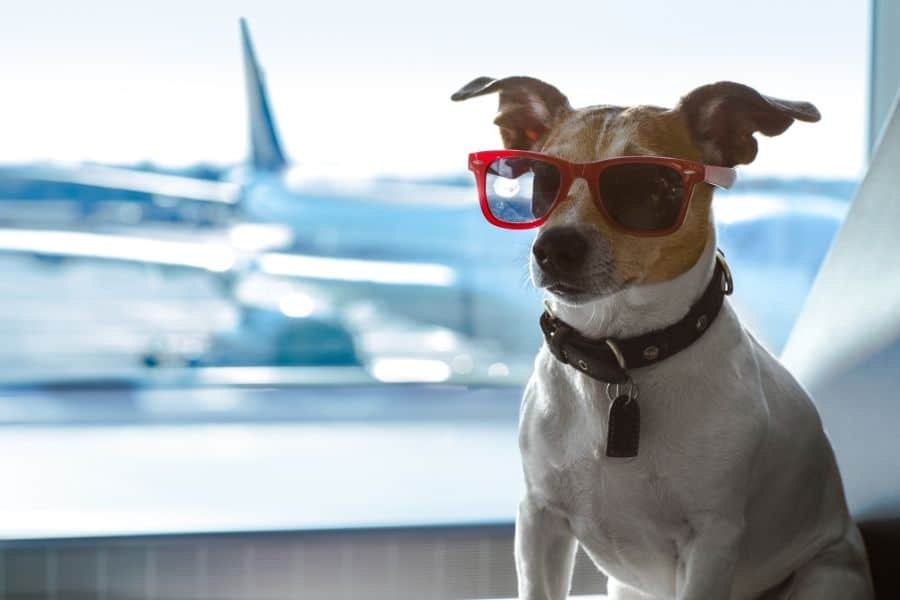
Some links in this article may be affiliate links, which means that if you purchase through them, I receive a small commission. This will never cost you extra. Please read the disclosures to learn more.
My Experience Flying with Pets
I moved from Boston, MA to Phoenix, AZ. The cities are approximately 2,500 miles apart and most of the way across the United States. I had two cats at the time and decided I would fly them to our new home.
Though I thought I had done my planning, I was in no way prepared for the trip. Hopefully, this article will help you to be better prepared flying with your pets.
Think driving with cats is more fun? I did that too, driving from New Jersey to Boston. Eight nightmarish hours that will never, ever be repeated. The better choice for me and my cats was flying, but I was not nearly as prepared as I thought I was for this kind of pet transport.
I recently had the opportunity to fly again with my pet. This time again was my cat (a different one!) And thankfully, I was prepared. It was a little challenging at times, but not a bad experience for either of us!
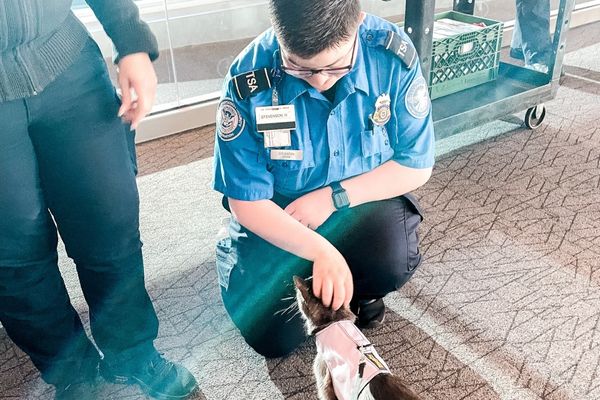
Pet Transport by Plane—Flying With a Cat (or Dog)
A person can only bring one pet at a time on the plane, so I took two flights over the span of a few days to get each of my cats to our new home. Not that they were grateful at all for my sacrifice!
It was stressful for all of us. But, the stress level was much less than a several-day drive across the country would have been. Especially given how difficult the eight-hour journey from New Jersey to Boston was.
Every airline has its own policy for pet transport, so it’s important to check before you book the flight. You’ll generally find pet-friendly airlines, but make sure you read through this to understand any requirements. There are a number of things for you to consider before you book your flight to make sure you’re prepared.
For example, each airline has its own requirements for pet carriers. I recently flew with my cat on Southwest, and looked into the Southwest pet carrier. They recommend it, though it’s not required.
These airline policies include a pet fee, health requirements (health cert), dimensions for carriers and the size of your pet, pet safety, and breed or type. Sometimes there are other restrictions. You also need to think about what you’re going to pack for the trip.
Additionally, airlines require a pet reservation as they generally limit the number of animals allowed on board. Even with a reservation, it’s a good idea to call a day or two before the flight to ensure you will be able to fly.
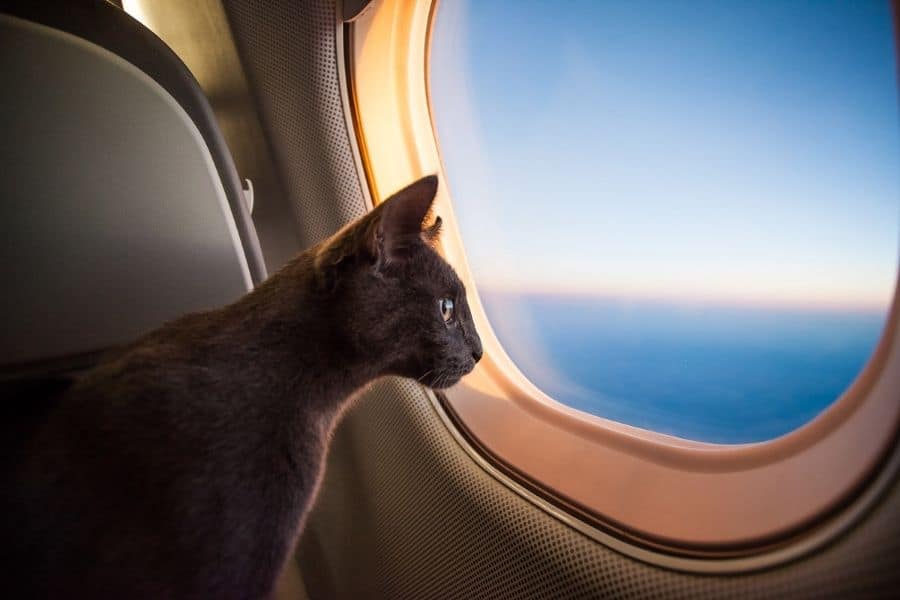
Pet Transport Fee
The cost to transport a pet by plane depends on the airline. There is a cost whether they go in the cabin or in cargo. Costs range from $100 to $500 and possibly more, depending on the airline. The cost depends on the size of the animal and if you are traveling one way or round trip.
Not all airlines do allow pets, and that is both on the plane and in cargo. So, don’t assume you can take your pet without checking.
Pet Transport Health Certificate
It’s important to research the requirements of where you are traveling before starting your journey. Traveling between states in the United States requires a health certificate signed by your vet within 30 days of travel. The cost can range between vets but be prepared to pay $25-$50.
Additionally, certain vaccinations may be required by states or countries. You may also need to bring proof of vaccination. It’s a good idea to bring some medical records as well.
As of this writing, there are several countries with a strict rabies quarantine for a few days. This includes Australia, Singapore, and New Zealand. A list of regulations by country is included on this page. However, you should do your research and check with the local embassy for the most updated requirements.
Information around myths with quarantines can be found here and another resource for quarantine information can be found here.
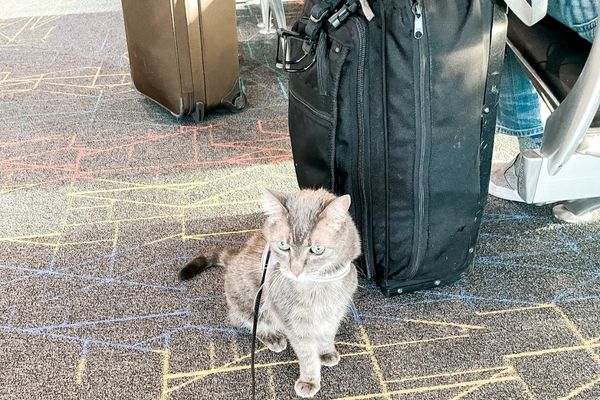
Carrier Dimensions
Carriers must be able to fit under the seat and the animal must be able to stand up and circle. Each airline has requirements for the allowable carrier size. As mentioned before, it’s best to confirm any information you find on the airline website.
Depending on the dimensions of the space and the airline’s requirement, 20 lbs. (9 kilos) is a good ballpark. If your pet is well under that amount, they can likely fit in the space provided. If they are at or over, it will depend on the specific airline requirements.
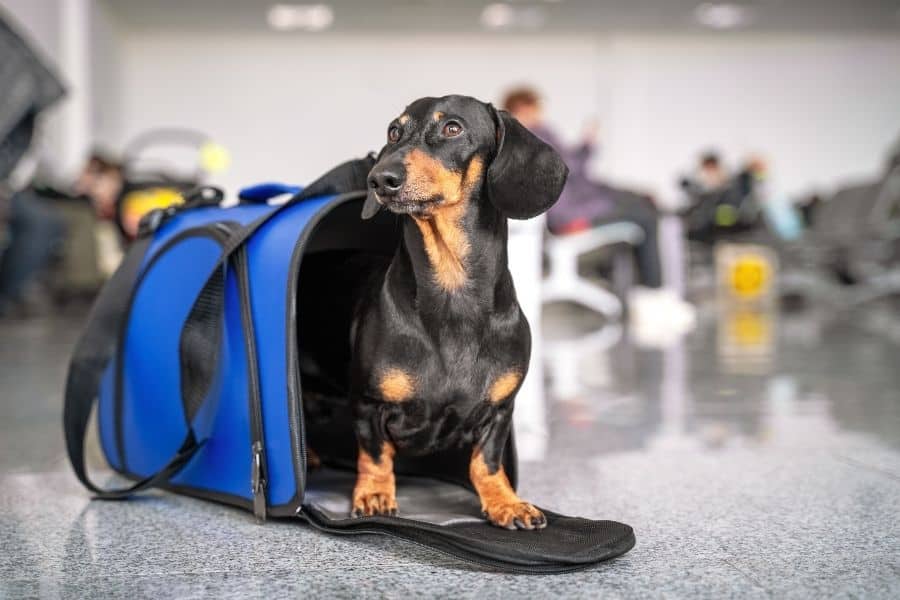
Larger animals must be boarded in cargo if they are allowed. There are airline-specific requirements for the dimensions of the carrier and sometimes the type of carrier. In this case, your pet goes below in the plane’s cargo hold.
An important thing to know is that animals are not supervised that fly in cargo. So, if your pet is stressed or gets sick, there is no one there to help.
Some airlines offer climate-controlled cargo spaces while others do not. Often, the ones that don’t will not allow you to fly your animal on the plane. However, you should ask to be sure.
Additionally, some airlines will not fly furry passengers in the cargo if temperatures are deemed to be extreme. This means airlines may not allow pets in cargo during certain times of the year and in some cases, in certain locations. For example, many airlines restrict flying pets in cargo from Phoenix during the summer due to the high temperatures.
Safety During Pet Transport on a Plane
Safety is a big consideration and I strongly advise you do your homework. You can find many articles like this one which talks about safety considerations with flying. This article also includes some 2017 safety statistics by airline.
There have been numerous horrifying articles in the United States of animals dying in-flight from various causes. These incidents have occurred both while traveling in the plane and in cargo.
Safety during pet transport is also a concern even if you are taking your animal on the plane. Think from your pet’s perspective. Even the most social of animals may be a bit anxious in the unfamiliar setting of an airport and on a plane. There are a lot of people, and new noises and smells your pet isn’t used to.
It’s best to keep your pet in the carrier and if you must take them out, make sure to have a leash or harness attached. In fact, some airlines require they be in the carrier for the entire flight.
If you are able to let them out, ensure you have a good grip on the leash if you let them out of the carrier. Not only because not everyone loves your pet as much as you do, but you also don’t want them to get hurt accidentally.
Keep in mind that your pet may be sensitive to the air pressure changes during ascent and descent. If you notice your pet is restless during these times, that is why. It might be helpful to put a hand on them in the carrier to provide some comfort.
Always be an advocate for your pet in the airport and on a plane. There was a recent death on a plane due to an owner being told to put their dog in the overhead bin for the flight. While we can all shake our heads in disbelief, tragedies like this do happen.
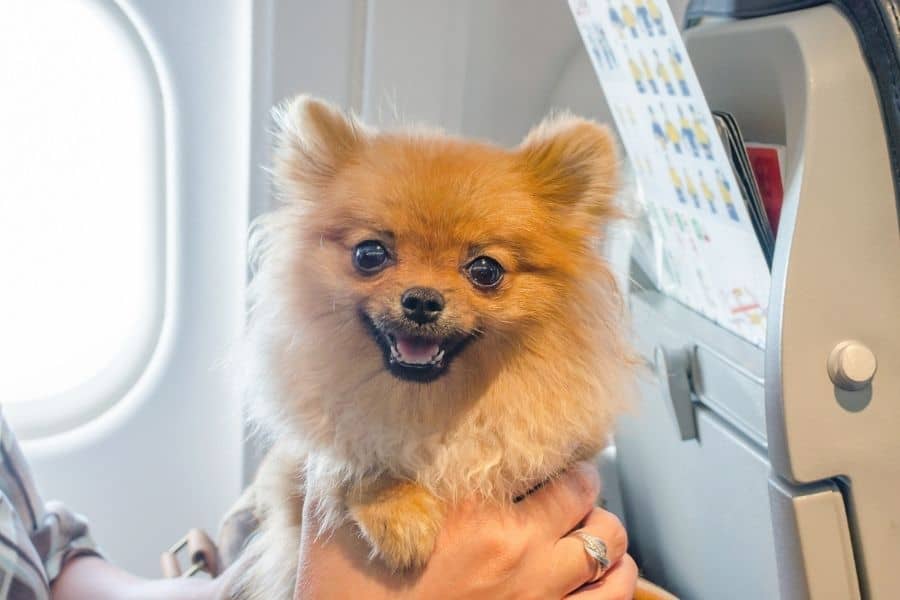
Breed Restrictions
There appears to be an increasing trend among United States-based airlines to ban certain breeds from flying in cargo. The “target” generally is brachycephalic or snub-nosed dogs including mixes. They often ban similar brachycephalic cats as well (like Persians).
There is some sensitivity to this in the United States given the increase in breed-ban legislation for “pit-bull-type dogs.”

You will want to check with the airline to make sure your dog will be able to fly with the carrier. Even if you get the reservation and pay the pet fee, that doesn’t mean the dog has been approved to fly.
You can typically find this information on the airline’s website. If not, contact them to check before you book your ticket.
Bring Fido has some incredible resources for travelers flying with pets including:
- Excellent recommendations and resources for planning your trip within the US.
- Airline pet policies
- Country pet policies
It’s always a good idea to check directly with airlines and to the country, you’re flying to just in case policies have changed.

Taking Pets through Security
Here is what I didn’t know before I took my first cat to the airport: security requires that you remove your pet from the carrier and walk them through the metal detector.
This may seem like an easy thing. But, for a cat who is used to staying 24/7 in a quiet home to be brought into a busy, noisy, brightly-lit airport with people rushing around and pushing past you, it can be terrifying. And it was.
You are required to remove your pet from the carrier. You run the carrier through the x-ray machine and you hold your pet (or walk them) through the x-ray machine that people walk through. It sounds easy enough, right? Of course, unless your pet is completely freaking out and then it’s a nightmare.
I wasn’t prepared and held my poor cat in a death grip much like a receiver that made a catch during a Superbowl game. People were trying to shove their way past me as I wrestled with my poor cat. I tried to wrap my arms around him to both provide comfort and to ensure he wouldn’t move an inch. I had visions of a black-and-white tuxedo cat who looked a lot like Pepe le Pew in Looney Tunes streaking through the airport.
A few days later I did it all over again with my other cat. But this time I knew what was coming and asked the man behind me in the security line to block people from shoving their way past so I could get my cat through security without the trauma of what felt like multiple tackles. It was so much smoother the second time around.
Pet Harness
Pro Tip: put a harness and a leash on your pet to ensure a good hold on them and ask the person behind you in the security line to hold people back. I recommend SturdiProducts walking vests for cats (and small dogs). This harness by Comfort Soft is another slightly-more affordable option.
For larger dogs, I love the Easywalk Harness. It’s secure and you get the added bonus of an optional loop in the front. When you use it, it helps to keep your dog from pulling. However, if your dog is good about walking on a leash, you can use the loop on their back.
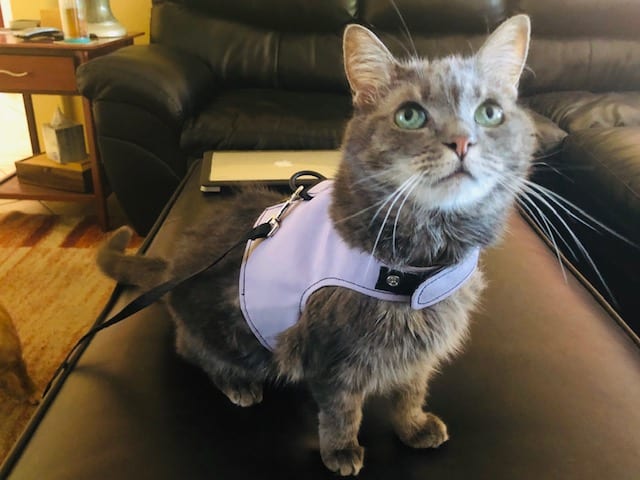
To Sedate or Not to Sedate
I did choose to sedate my cats when I traveled across the United States. I highly recommend testing it out on them before you travel, and I did a week or so before we left. They rolled around on my bed in a seemingly drunken frenzy and it was quite entertaining.
I have read some articles since then advising not to sedate it so it is absolutely something to discuss with your vet. I did opt to give a small dose to my cats and in their case, I was glad that I did. And I think they were as well.
On my more recent flight with my kitty, Noel, I talked with my vet. She’s a therapy cat and used to being in her harness around people. So, I figured the airport wouldn’t be a big deal.
However, she doesn’t like being in a carrier. And the airline required she be during the duration of the flight. I decided to give her a little bit of a medication to make her a little sleepy. I’m not sure it did much but she was a bit calmer than I expected.
It’s important to know your pet and their likes and dislikes. Also, if you’re going to medicate, talk with your vet and be sure to test it in advance of your flight.
For most dogs, you probably won’t need to consider a sedative unless they are really anxious. Of course, you’ll want to get them used to being in a carrier before the flight to make sure they feel comfortable enough.
Since many dogs that are crate-trained actually enjoy being in a crate, it can be a comfort in unknown situations.
Other Considerations
Some other things to consider are when and if you feed and water your pet before a flight, exercise, potty breaks. For food, if you’re unsure how your pet will respond to the stress of the airport and the flight, it’s a good idea to consider not feeding or reducing the food.
Reducing water right before a flight when they won’t be able to potty is also a good idea but in both cases, consider your pet’s specific needs.
A great way to burn off some stress for a dog is to take them for a walk but it depends on your dog’s temperament. Many airports now have “potty stations” which can be very helpful. Though an animal that is stressed may not use it.
And keep in mind your pet can be denied at the gate. You are allowed to have your pet out of the carrier in the airport if they are restrained with a leash and/or harness. However, if they are going to be a whirling dervish (don’t you just love that visual?) I highly recommend you keep them in their carrier.
What Should You Pack to Fly with Your Pet?
There are a number of things you should consider packing when you travel with your pet. This includes things like food, bowls, toys, treats, and others. You may not need most of these on the plane, though you will want a bowl and water, poop bags, any medications you may need, and a mini first aid kit, just in case.
If you fill this out, you’ll get a free packing list for a dog that you can tailor to your specific needs. You can adapt this to cats easily as well.
If you sign up, you’ll also get access to the My Flying Leap newsletter offering travel tips and inspiration.
Some of My Packing Recommendations
Here are some of my recommendations for what to bring with your dog when you are flying.
- Collar, leash, and tags (harness if your dog wears one)—I use the EasyWalk Harness with my big dog as it has an added bonus of a hook at his chest to reduce his pulling. Here is a similar harness made by Petsafe. For my small dog (who thinks he’s HUGE) I use one like this Petsafe harness. It’s a great brand and I like the harnesses that are more sturdy to ensure he doesn’t wriggle out of it. If you’d prefer to use a collar and not a harness, I highly recommend a martingale collar. It has a loop so it tightens when you pull the leash so the dog can’t back out of it. Max and Neo martingales are great and they give back to support local animal rescues with every purchase.
- Water and a bowl—It’s a good idea to bring water, even if you decide to not give it. I often bring a combination water bottle and bowl wherever I go with my dogs. It’s nice and convenient and fillable at the airport.
- Poop bags—You can never have too many poop bags. I love these Planet Friendly Poop Bags by Frisco. You can purchase a clip-on dispenser that makes it quite easy by always having them handy. If you’d rather buy the bags in bulk (I did say you can never have too many!) they come with the dispenser. They conveniently come in scented as well in case your precious pup needs them.
Should you Fly with Your Pet?
There is a lot to think about when traveling with your pet. The decision to fly should not be taken lightly, and everything from airline requirements, safety, and the well-being of your pet should be considered. This article by the Humane Society walks through some of the decision points and recommendations.
There are options for pet transport with companies that specialize in it. This association provides resources, though since there is likely an association fee, it may not include all organizations.
Please do your homework to make sure it’s a solid company with a good reputation, regardless of which places you look at. It only takes one mistake for your pet to be injured or worse. It’s worth researching and checking reviews before booking.
If you can’t bring your pet or decide not to, this article has some great tips for selecting care while you’re gone.

Abby is our cover photo dog. Isn’t she beautiful? She and her mom, Sharon, volunteer at the Phoenix Sky Harbor Airport in the Navigator Buddies Program. For a regular dose of adorable Abby updates, please see her Instagram page @abbythetherapydog.
You Might Also Like
- Dining With Dogs in a Pet-Friendly Restaurant
- Care for When You Can’t Bring Your Pets
- Safely Driving with Dogs: the Ultimate Guide
- Tips to Take Your Dog on Vacation (+ What to Do When You Can’t!)
- Hiking with a Dog—Top Tips for Safety and Fun
Like it? Pin it!

